World War One: How Wales celebrated the Armistice
- Published

People gathered outside City Hall in Cardiff to rejoice at the end of the war
As the guns fell silent 100 years ago, newspaper sellers on every street corner in Wales proclaimed that World War One was over - and the celebrations that followed were captured in print up and down the country.
Under the headline "Great Joy-Day in City and Village" the Western Mail's edition on 12 November described how scenes of jubilation were repeated from coast to valley.
This report from Cardiff reads: "In most places, there was an absolute stoppage of work. Shortly after the dinner hour the shops were closed - the staffs would not brook restraint, and the employers readily relaxed rules and regulations.
"The tramway girls got off the cars: they must, they said, join in the celebrations.
"It was a day of great rejoicing and abandon, and most people went to sleep at a late hour, satisfied that they had done the celebration of peace in a right worthy fashion."
Great crowds gathered in St Mary Street and outside City Hall as the news, sounded by sirens, was broadcast to all.
"Shortly before noon, processions from all directions converged on Cathays Park, and when the hour of twelve struck the spacious square outside the civic buildings was thronged with a wildly enthusiastic crowd," the paper reported.
The city was addressed by civic leaders - the mayor and Lord Bute among others - while the Welsh Regiment band marched ahead of a company of men, and crowds sang the national anthems and flags of the Allied nations were unfurled.
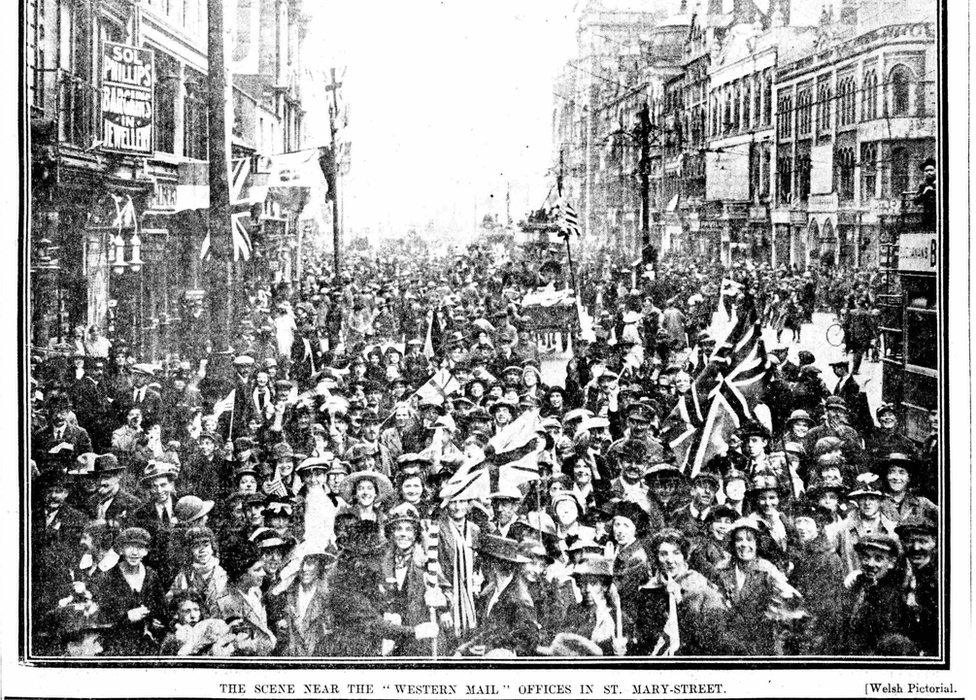
Crowds thronged St Mary St, Cardiff as soon as the news was confirmed
Schoolchildren were granted a week's holiday from school to mark the great event - that is, if their schools were not already closed because of the Spanish flu epidemic sweeping the country.
A report from St Mary's Mixed and Infants school record book in Clarence Road, Grangetown, which is preserved in the Glamorgan Archives, states: "Towards 11 o'clock it became evident by the blowing of hooters and other noises that the Armistice treaty with Germany had at last been signed and the local newspapers had published a report that the moment the news arrived the schools would be closed.
"The scholars were assembled in the yard, cheers were given and they were dismissed at 11:30. Later on a circular arrived stating that no school would be held for the rest of the week."
Across the coalfields of south Wales, where so much vital work in fuelling the war effort had gone on, collieries sounded hooters and detonators were discharged.
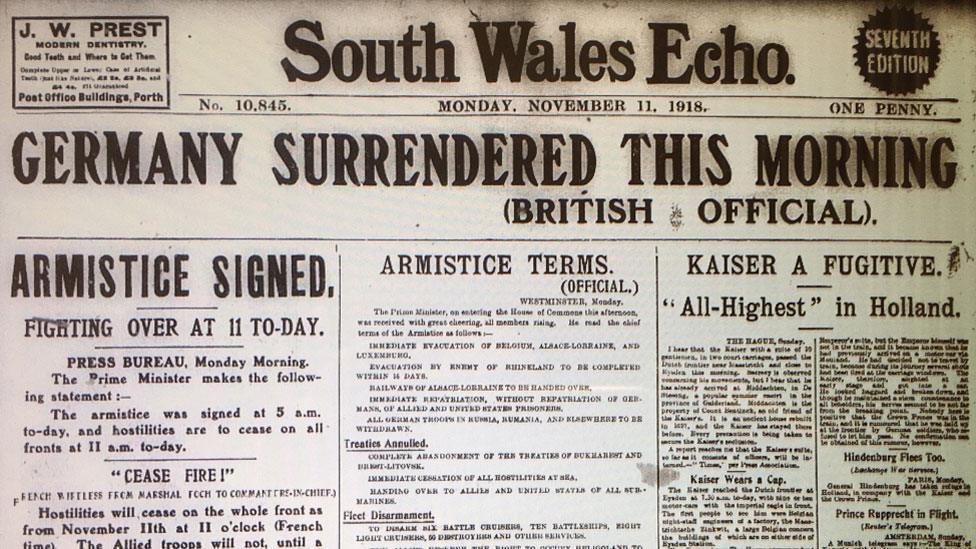
The South Wales Echo managed to get the news out on 11 November in one of its later editions
In the Rhondda valleys, bonfires were lit at Wattstown, Ynyshir and Porth, while at 'Treorky' "a huge bonfire was lit on one of the colliery tips".
In Swansea, the South Wales Weekly Post report entitled Parade of Joy described how "the town was given up to rejoicing and congratulations".
As in Cardiff, the workers were given a holiday from work for the rest of the day and the next following the announcement, and a "great procession" assembled at the Guildhall at 14:30 and marched through flag-decorated streets, including a French contingent "preceded by a standard-bearer with an immense tricolour".
The parade ended at the city's St Mary's Parish Church which was "overflowing" with worshippers. At the city's Exchange, smoking was allowed for the first time ever to mark the special occasion.
As night fell, crowds let off squibs and rockets and "sang the Allies' National Anthems and popular airs".
However the paper noted the crowds were "exuberant, but restrained in a measure", following an earlier appeal from the city's mayor that there should be "no excesses" in the light of the many fallen soldiers from the conflict.
Neighbouring towns - Briton Ferry, Aberavon, Sketty and Neath - celebrated in similar fashion. In Carmarthen, another parade took place headed by a Salvation Army band and wounded soldiers carrying flags.
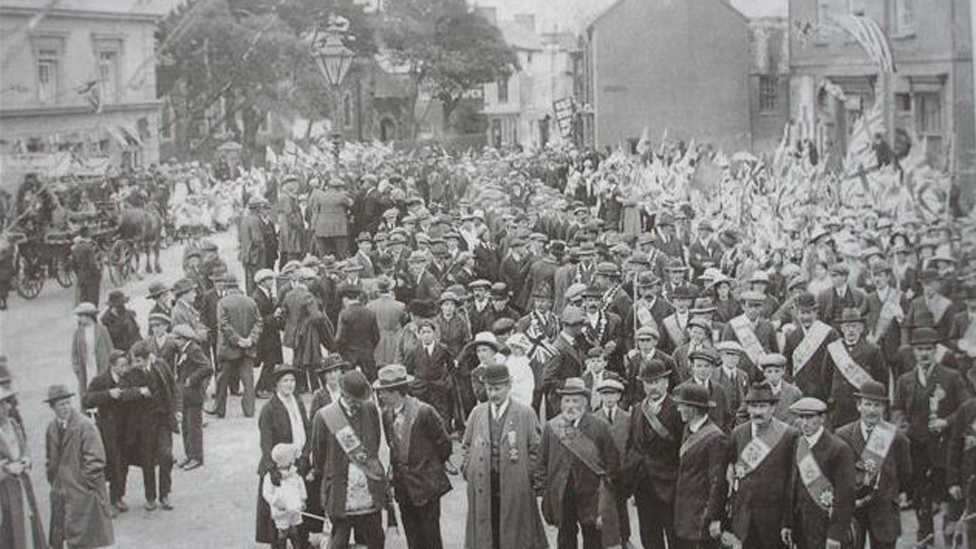
Charitable organisation Oddfellows in Fishguard, Pembrokeshire, led the celebrations there
In Milford Haven, as the Haverfordwest and Milford Haven Telegraph reported: "The Docks were full of craft - HM drifters, trawlers and large patrol vessels, and out in the Haven stretching from Dale Roads to Newton Noyes Pier vessels of various sizes and purposes took up the strain.
"Simultaneously up went the flags. So deafening was the noise that for an hour it was almost impossible to enter into any conversation."
The outbreak of flu had an impact on the celebrations in Brecon, Powys, and even on the reporting, as the Brecon and Radnor Express explained to its readers, apologising for the "brief and joint notices" of events: "Influenza has so much affected the staffs of the papers that nothing more than a brief sketch is possible."
The town held a service of thanksgiving at St Mary's Church while the South Wales Borderers band played in the town. The paper noted: "A curious incident was the carrying of Union Jacks by some of the German prisoners employed in the town and district."
Fireworks were let off in the evening and bells rung. "Illuminations of shops and private houses were as general the tyrant, influenza, permitted."
In Aberystwyth, "the principal streets were soon thronged with people - people who smiled and shed tears at the same time. Few homes have been untouched by war. There are thousands of gallant men and boys to return, but there are many who have found graves in foreign lands," the Cambrian News reported.
But the children of the town led the way in rejoicing, and they were joined by a number of wounded soldiers, forming a procession along the promenade, "a living illustration of the tragedy that had come to a close".
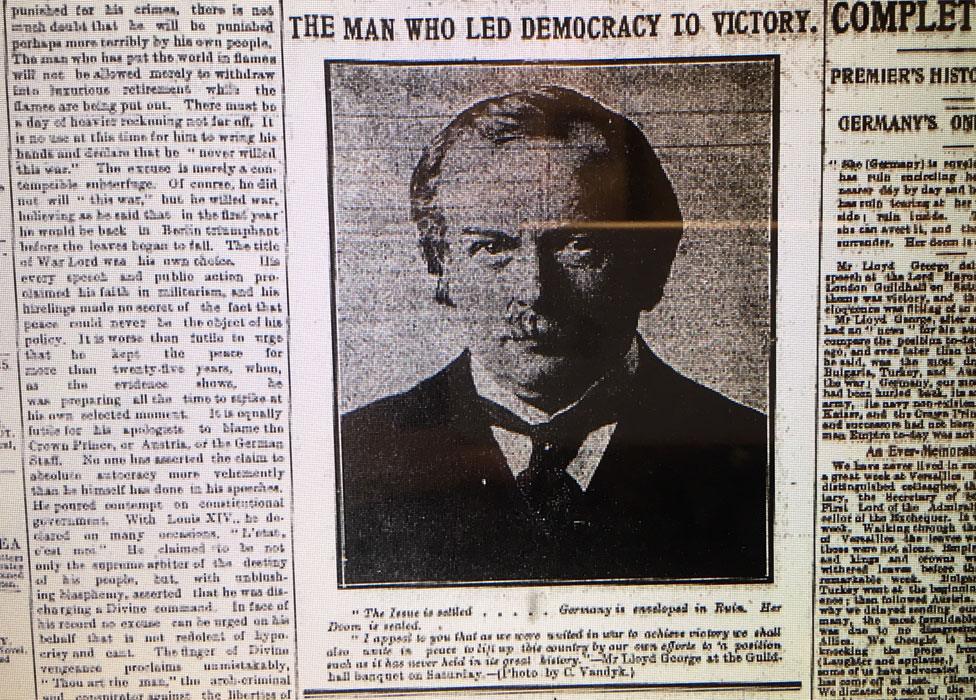
Pictures of Prime Minister David Lloyd George were carried in many Welsh newspapers
In north Wales, the news that the armistice had been signed (shortly after 05:00 local time in Paris) reached the naval station at Holyhead on Anglesey at 07:00, the North Wales Chronicle reported.
The tidings spread east across the coastline through the morning by passengers travelling on the early morning train from Holyhead port to Chester.
As in the south, flags were broken out to decorate the streets - the reporter wondered if the shops had been laying in stocks of flags and rosettes, so numerous were their appearance.
In Bangor, Gwynedd, the paper noted: "With an alacrity which did the shopkeepers and residents of High-street infinite credit, Union Jacks, Stars and Stripes, the Tricolour, the Welsh Dragon and flags of other nations (not to say a few which could not claim association with any nation, and which in fact resembled bedspreads) make their appearance, and transformed High-street into quite a festive thoroughfare."
RAF airmen from nearby Abergwyngregyn forgot Bangor was out of bounds for them "owing to the influenza epidemic" and arrived in lorries. They "vociferously chorused the great news to the staccato accompaniment of a raucous hooter".
A number of impromptu processions happened after lunch, including one in fancy dress of naval men from Menai Bridge, and two more of Normal College students and University College students.

The Armistice 100 years on

Long read: The forgotten female soldier on the forgotten frontline
Video: War footage brought alive in colour
Interactive:, external What would you have done between 1914 and 1918?
Living history: Why 'indecent' Armistice Day parties ended

But the most remarkable display of the day came from the air: "First came two airships (one of an unusually large type)... their silver covers glistening in the sunshine, they presented a magnificent spectacle.
"Then two aeroplanes, in charge of skilful pilots, performed 'stunts' which made the crowd fairly gasp, especially when one of them looped the looped (sic) rather close to the roofs."
Church bells were heard across towns such as Caernarfon, with services of thanksgiving reported at churches and chapels for a number of days, including notice of a special service at Bangor's Jewish synagogue on the Saturday after armistice.
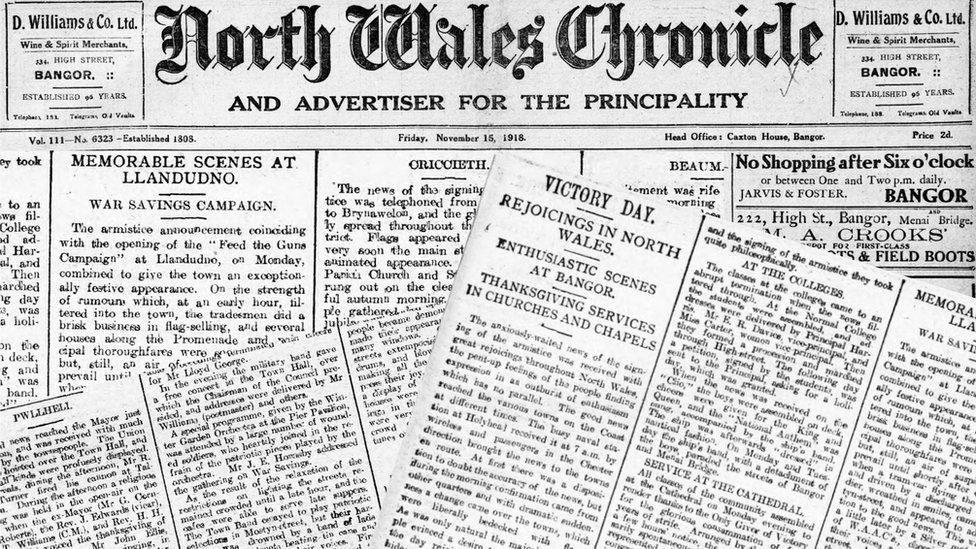
Airships, gun salutes and flags in north Wales
A procession in Llandudno along the town's promenade was boosted from the water by a "warship of submarine-chaser type", accompanied by an airship which flew above the happy marchers at a very low altitude.
"The warship fired several shots and the airship discharged its machine gun - a most thrilling spectacle which will not soon be forgotten by the thousands of people thronged the promenade," the paper noted.
But special mention must be made of "the quiet little hamlet of Llanystumdwy" on Gwynedd's Llŷn Peninsula. As a reporter noted: "Nowhere in the wide world was the enthusiasm so heart-felt."
Why? "It was an outburst of something deeper and more lasting than passing enthusiasm; it was real love and admiration for the lad of the village, "David," who has so successfully steered the barque of State over the troublous seas of the last four years."
The "lad" was David Lloyd George, the Liberal prime minister who had led the country, in the end, to victory and peace once more.
- Published6 November 2018
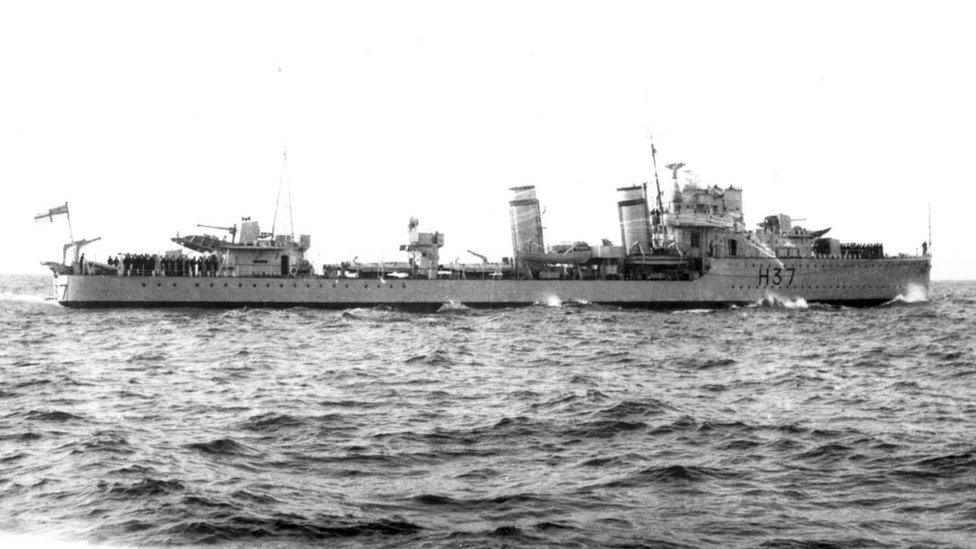
- Published16 June 2016

- Published7 November 2018
